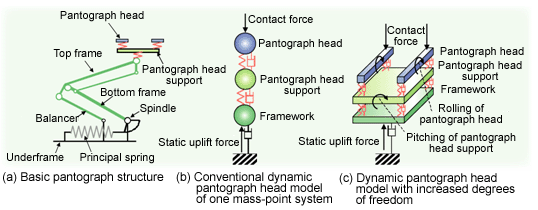|
The conventional analysis model for evaluating pantograph compliance amplitude characteristics is a simple one mass-point system which assumes only the vertical motion of the pantograph head. This model is not able to clarify the effect of the distance between pantograph heads or trolley wire lateral deviation on compliance amplitude characteristics.
The RTRI therefore increased the analysis model's degree of freedom to take into account the distance between pantograph heads and their rolling/pitching modes (Fig. 1). It was confirmed that the compliance amplitude obtained by this model agreed with test results more accurately than with the conventional model, and the effect of the distance between pantograph heads and trolley wire lateral deviation on compliance amplitude characteristics was quantified.
The RTRI also proposed a technique to improve compliance amplitude characteristics by setting different constant values in the lateral and longitudinal directions for the pantograph springs to support the pantograph head, then positively exciting the pantograph head's rolling and vertical swing modes. Results confirmed the effect of this technique in improving the compliance amplitude characteristics (Fig. 2).

Fig. 1 Pantograph model

Fig. 2 Compliance amplitude characteristics (test results)
HOME > Major Results of Research and Development in Fiscal 2004 > II Economy/Efficiency

RTRI HOME
Copyright(c) 2005 Railway Technical Research Institute,Tokyo Japan, All rights reserved.
|

